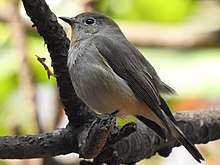Taiga flycatcher
The taiga flycatcher or red-throated flycatcher (Ficedula albicilla) is a migratory bird in the family Muscicapidae. The species was first described by Peter Simon Pallas in 1811. The female has brown upper parts with a blackish tail flanked by white. The breast is buffish with underparts mostly white. The male has ear coverts and sides of the neck blue-tinged grey with breeding males having orange-red coloration on the throats. Unlike the taiga flycatcher, the female of the similar red-breasted flycatcher has brown tail while the red colour in breeding males extend up to the breast in red-breasted flycatcher. It breeds in northern Eurasia from eastern Russia to Siberia and Mongolia. It is a winter visitor to South and South-east Asia in Bangladesh, Bhutan, India, Cambodia, Laos, Myanmar, Nepal, Malaysia, Thailand, China, Vietnam, and Japan. Its natural habitat is taiga forest. It is a rare vagrant to western Europe.
| Taiga flycatcher | |
|---|---|
 | |
| Scientific classification | |
| Kingdom: | Animalia |
| Phylum: | Chordata |
| Class: | Aves |
| Order: | Passeriformes |
| Family: | Muscicapidae |
| Genus: | Ficedula |
| Species: | F. albicilla |
| Binomial name | |
| Ficedula albicilla (Pallas, 1811) | |
| Synonyms | |
| |
It was formerly considered a subspecies of the red-breasted flycatcher.
The genus name is from Latin and refers to a small fig-eating bird (ficus, fig) supposed to change into the blackcap in winter. The specific name albicilla is from Latin albus, white, and New Latin cilla tail; this meaning of cilla arose from a misunderstanding of motacilla, the name for the wagtail.[2]
_at_Sindhrot_near_Vadodara%2C_Gujrat_Pix_112.jpg)
- At Chandigarh, India
 In Madobpur Lake, Shylet, Bangladesh
In Madobpur Lake, Shylet, Bangladesh In Hyderabad, Telangana, India
In Hyderabad, Telangana, India Male
Male Female
Female
References
- BirdLife International (2012). "Ficedula albicilla". IUCN Red List of Threatened Species. 2012. Retrieved 26 November 2013.CS1 maint: ref=harv (link)
- Jobling, James A. (2010). The Helm Dictionary of Scientific Bird Names. London, United Kingdom: Christopher Helm. pp. 38, 167. ISBN 978-1-4081-2501-4.
